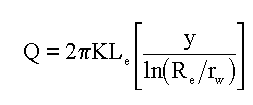Bouwer and Rice Auto-Solve Method
Bouwer and Rice Automatic Parameter Estimation
View | Bouwer and Rice Automatic
See Also:
Excluding Points from Analysis
The Bouwer and Rice method applies to the aquifer scenario shown in the figure.

The aquifer can be either fully penetrated or partially penetrated by the screened portion of the well. The Bouwer and Rice method is designed for unconfined aquifer scenario's, however use in confined or leaky aquifer scenario's can give reasonable estimates of hydraulic conductivity.
Value Substitutions:
In some aquifer scenario's, the Bouwer and Rice formula will result in taking the logarithm of a negative number. The following value substitutions will be made to prevent this occurrence.
- If the distance from the top of the water table to the bottom of the well screen is greater that the aquifer saturated thickness (screen penetrates below the base of the aquifer), the aquifer saturated thickness is used for the distance from the top of the water table to the bottom of the well screen.
- If the screen length is greater that the distance from the top of the water table to the bottom of the well screen (screen sticks above the water table), then the top of the water table to the bottom of the well screen is used for the screen length.
- If the screen length is greater than the aquifer saturated thickness, the aquifer saturated thickness is used for the value of screen length.
Hydraulic conductivity is determined with Equation 1 below:
Equation 1

Using either Equation 2 or 3 below, and the A, B, or C values for the partial penetration scenario, radius of influence is calculated for Equation 1.
Equation 2

Equation 3

Partial or Full Penetration?
Super Slug automatically determines A, B, and C based on the amount of penetration of the aquifer by the well. Super Slug automatically determines if the well is fully or partially penetrating and selects the proper parameters. If the well is greater than 95% fully penetrating, Super Slug will assume full penetration and use Equation 3.
For the automatic parameter estimation, Super Slug determines hydraulic conductivity for each pair of consecutive time and drawdown values (except for t = 0). The output file created for the Bouwer and Rice method will include the hydraulic conductivity of each data set. Both the arithmetic mean and geometric mean of all hydraulic conductivities calculated.
Sensitivity Analysis:
In addition to the geometric and arithmetic means described above, Super Slug also uses a sensitivity analysis to solve the Bouwer and Rice method. This method is described by Kemblowski and Klein (1988). In some test data sets, a divide-by-zero error occurred in the calculations. In these situations, no sensitivity analysis can be performed.
Estimating Volume Rate of Flow into the Well
Bouwer (1989) indicated that the rate of flow into the well during the slug test could be estimated with the formula:

Where:
Q = Volume rate of flow into the well
K = Hydraulic conductivity of aquifer around the well
Le = length of screened section of well
y = vertical difference between water level inside of well and static water table outside of well
Re = effective radial distance over which y is dissipated
rw = radial distance of undisturbed portion of the aquifer from centerline
For use in Super Slug, K, Re, are calculated by the Bouwer and Rice automatic solution. Other values are input provided by the user. Q is calculated for each time measurement using the K and Re values of that time measurement.
Excluding Unwanted Data
Unwanted data from the beginning and the end of the test can be excluded from the analysis. Select one of the graphical analysis methods and exclude any undesired data. Then run the automatic test.